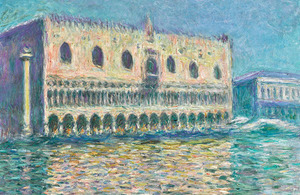Spellbinding Monet work worth £28 million at risk of being lost
Monet’s 1908 work ‘Le Palais Ducal’ is at risk of being lost abroad unless a UK buyer can be found

Claude Monet ‘Le Palais Ducal’
- Valued at more than £28 million the work is one of a small number of the artist’s works depicting Venice
- Arts Minister Rebecca Pow leads call to save the treasure for the nation
Arts Minister Rebecca Pow has placed a temporary export bar on Claude Monet’s ‘Le Palais Ducal’ in the hope that a UK buyer can be found to keep the work in the country.
Valued at £27,534,000 plus VAT of £706,800, the painting was completed following Monet’s 1908 visit to Italy with his second wife Alice. The work shows a sun-lit Doge’s Palace in Venice and its reflection in the water.
Monet visited Venice as a respite from working on his famous water lily series and during the holiday he began to paint. The artist had anticipated a return to the city, however Alice’s failing health hindered the couple from returning to Venice in 1909.
This meant that the Venetian series has a smaller number of completed canvasses and the images have a wider range of motifs compared to Monet’s other series of works. The artist worked on this particular canvas in situ during the 1908 visit but it is thought that the work was completed at his home in Giverny during 1911-1912.
Monet’s inability to return to Venice and paint a complete series, combined with the phenomenal success of the water lily paintings, has led to the Venetian paintings remaining relatively overlooked.
Arts Minister Rebecca Pow said:
Monet is one of the world’s most famous and celebrated artists and his works still resonate more than 100 years on. With his trademark ingenuity he managed to capture the changing ways people viewed nature and the world around them at the turn of the century.
This is a rare and beautiful example of Monet’s Venetian studies and I hope that the funds can be raised to keep this treasure in the UK.”
Born in Paris in 1840, Oscar-Claude Monet (1840 - 1926) was a prolific French painter and a key founder of the Impressionist movement. Monet was introduced to painting from nature by Eugène Boudin and went on to become one of the foremost artists of the late nineteenth and early twentieth century.
The term ‘Impressionism’ comes from the title of Monet’s work ‘Impression, soleil levant’ which was first exhibited in 1874. Monet’s style of painting focused on capturing the same scene many times over with changing levels of light and the seasons.
The Minister’s decision follows the advice of the Reviewing Committee on the Export of Works of Art and Objects of Cultural Interest (RCEWA). The committee noted that the work was a beautiful painting from an important period in the career of one of the foremost artists of the late nineteenth and early twentieth century. They also noted that examples of the artist’s post 1900 travelling works are rare in UK public collections.
The RCEWA made its recommendation on the grounds of the painting’s outstanding aesthetic importance and its interest for the study of Monet’s Venetian series.
Committee Member Aidan Weston-Lewis said:
This exceptional painting brilliantly demonstrates the pivotal status of Monet’s later art between impressionist representation and modernist abstraction. The massive, block-like form of one of Europe’s most celebrated buildings appears to float, mirage-like, on the waters of the Venetian lagoon. Its façade, dissolving in the sunlight, is separated from its choppy reflection by a strip of blue, transforming the picture surface into a loose grid of geometrical shapes. This would be a highly desirable and no doubt very popular addition to any public collection in the UK.
The decision on the export licence applications for the painting will be deferred until 8 November 2019. This may be extended until 8 May 2019 if a serious intention to raise funds to purchase it is made at the recommended price of £27,534,000 plus VAT of £706,800.
Offers from public bodies for less than the recommended price through the private treaty sale arrangements, where appropriate, may also be considered. Such purchases frequently offer substantial financial benefits to a public institution wishing to acquire.
ENDS
Notes to editors
-
Organisations or individuals interested in purchasing the painting should contact the RCEWA on 0845 300 6200.
-
Details of the painting are as follows: Claude Monet (1840-1926) Le Palais Ducal, 1908 Oil on canvas 81 x 93 cm, signed and dated bottom right ‘Claude Monet 1908’
-
Provenance: Galerie Durand-Ruel & Galerie Bernheim-Jeune, Paris (jointly acquired from the artist on 8th March 1913). Paul Cassirer, Berlin (on consignment from the above from 1914). Hans Wendland, Berlin (acquired from the above on 19th January 1918). Galerie Thannhauser, Lucerne, Berlin & Munich (acquired from the above on 4th September 1924). Erich Goeritz, Berlin & London (acquired from the above on 1st April 1926. Deposited in the Toronto Art Gallery, Toronto, from 1946 until 1950). Thomas Goeritz, London (by descent from the above circa 1957). Thence by descent to the present owner
-
The Reviewing Committee on the Export of Works of Art and Objects of Cultural Interest is an independent body, serviced by The Arts Council, which advises the Secretary of State for Digital, Culture, Media and Sport on whether a cultural object, intended for export, is of national importance under specified criteria.
-
The Arts Council champions, develops and invests in artistic and cultural experiences that enrich people’s lives. It supports a range of activities across the arts, museums and libraries – from theatre to digital art, reading to dance, music to literature, and crafts to collections. www.artscouncil.org.uk.